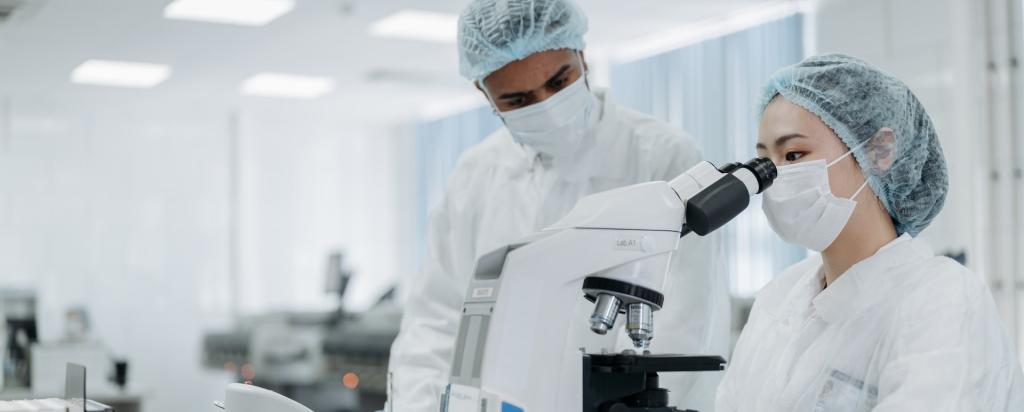
Published on the 20th November 2015 by ANSTO Staff
ANSTO and Australian Synchrotron researchers are collaborating on a number of projects that have been funded by the Australian Research Council (ARC) and other funding organisations.
“Collaboration in these projects, which were awarded highly competitive funding, is a testimony to the expertise of our researchers and the quality of research using our instruments,” said Rob Robinson, Acting Group Executive, Nuclear Science and Technology (pictured below right). “This brings the total value of ARC grants with ANSTO collaborators to almost $4 million, as well as more than half a million for the Synchrotron collaboration.”
Biomedical scientists Richard Banati and Marie-Claude Gregoire are co-investigators on an ARC Linkage grant with the University of Sydney and others for $1,030,000 to show how the hormone oxytocin interacts with neural social and reward pathways to guide social behaviour. The project will use ANSTO’s radio-labelling techniques in combination with positron emission tomography to track oxytocin and show what region of the brain oxytocin impacts to influence social cognition and behaviour in humans.
Environmental researchers Dioni Cendon Sevilla and Mike Hotchkis are co-investigators on an ARC Linkage Infrastructure, Equipment and Facilities grant for $600,000 awarded to the University of Adelaide to establish an Australian national facility for noble gas radio-isotope measurements. The facility is designed to provide researchers with the ability to accurately date water and ice cores using natural radio-isotopes in the sample. The radioactive noble gas isotopes extend the dating range out to 1 million years.
Adrian Hawley of the Australian Synchrotron is a co-investigator on a $523,000 ARC Discovery Project grant to Monash University that aims to deliver new understanding of the processes of milk digestion. The project plans to link nanostructure formation in milk with composition during digestion and the subsequent delivery of nutrients using both synchrotron and microscopy techniques.
Instrument scientist Andrew Nelson is involved in a $790,000 Marsden Fund grant awarded to Prof Jadranka Travas- Sejdic of the University of Auckland to investigate stretchable polymer electronics that stick and heal.
Several weeks ago, ARC funding for a number of projects involving ANSTO researchers was also announced.
Senior researcher and instrument scientist Frank Klose is a co-investigator on an ARC Discovery Project grant for $243,000 awarded to the University of New South Wales to investigate transition-metal-oxide heterostructures. These structures have future technological applications because they combine quantum size effects with effects of strong electron correlations such as magnetic switching, multiferroic coupling or superconductivity. Neutron scattering and optical spectroscopy will be used to gain detailed insight into the magnetic and electronic properties of these structures.
Instrument scientist Chris Garvey is a co-investigator on an ARC Discovery Project grant for $421,000 awarded to the University of New South Wales to develop new nanostructures with optimised shapes for biological applications. The project aims to create elongated self-assembling polymers to interact with cells that could assist in the creation of better drug carriers for more efficient disease treatment.
Simon Clark of Macquarie University, who holds a joint position 50% funded by ANSTO, is the recipient of funding for two projects. He received an ARC Discovery Project grant $262,000 to develop new methods to provide insights into the structure of the Earth’s upper mantle and $547,000 in Linkage funding for Infrastructure, Equipment and Facilities to establish high pressure equipment to form a virtual facility for experimentation into mantle geodynamics and element transport in fluids. This equipment will be used both at the Australian Synchrotron at the OPAL research reactor.
The ARC's Discovery funding schemes recognise the importance of fundamental research to the national innovation system. The national innovation system includes the people (for example, in government, higher education and business), processes and relationships involved in 'new' knowledge in a knowledge-based economy.
The Linkage Infrastructure, Equipment and Facilities scheme provides funding for research infrastructure, equipment and facilities to eligible organisations. The scheme enables higher education researchers to participate in cooperative initiatives so that expensive infrastructure, equipment and facilities can be shared between higher education organisations and also with industry. The scheme also fosters collaboration through its support of the cooperative use of international or national research facilities.
The Marsden Fund which is administered by the Royal Society of New Zealand supports excellence in science, engineering, maths, social sciences and the humanities in New Zealand by providing grants for investigator-initiated research.